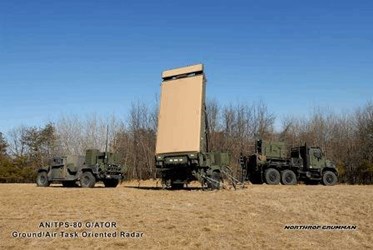Northrop Grumman Showcases Multi-Role G/ATOR Radar For U.S. Marines
By Jof Enriquez,
Follow me on Twitter @jofenriq

Northrop Grumman showcased recently its next-generation, multi-mission radar system that replaces five legacy U.S. Marine Corps radars.
The Marines now have the first six of 45 Ground/Air Task Oriented Radar (G/ATOR) systems to undergo developmental tests with operational assessments this year, leading to delivery of the first operational air unit in February 2018, said John Karlovich, G/ATOR’s program manager, reports C4ISRNET.
In development since 2007, G/ATOR is designed to provide the Marines with enhanced ability to detect, track, and provide target quality data to engage hostile aircraft, cruise missiles, unmanned air vehicles, rockets, mortars, and artillery, as well as provide air traffic control capabilities.
It has three subsystems: the Radar Equipment Group (REG), the Communications Equipment Group, (CEG), and the Power Equipment Group (PEG). The REG antenna at Northrop’s facility adjacent to Baltimore-Washington International Airport was shown to be capable of detecting aircraft as far north as New York City. The Humvee-mounted CEG accepts and encrypts targets from REG, while the PEG is a 60-kilowatt generator on a 7-ton truck, which tows the REG, according to C4ISRNET.
The G/ATOR system uses Northrop Grumman's Active Electronically Scanned Array (AESA) radar technology and advanced Gallium Nitride (GaN) technology, which allows lower input power needs, higher efficiency and higher output power. This higher output power improves threat detection and tracking ranges for all four G/ATOR mission capabilities: air surveillance, weapon cueing, counter-fire target acquisition, and air traffic control.
It also features multi-network compatibility with other U.S. military command and control systems, and a scaleable open system architecture that allows future upgrades, depending on operational needs.
“We are capable of adding additional functions such as theater ballistic mission capability, additional counter unmanned aerial systems capability such as low, slow, small; it already has some anti-jamming capability, but more could be added,” said Roshan Roeder, VP of the global ground-based radar land and avionics C4ISR division at Northrop Grumman Mission Systems, to C4ISRNET.
Northrop Grumman began production of the G/ATOR system earlier this year, according to The Baltimore Sun. All 45 (G/ATOR) units are scheduled to be delivered by 2024. The defense contractor says that, in addition to producing the radar system for the Marine Corps, it has received inquiries from U.S. allies who are interested in purchasing the radar.
